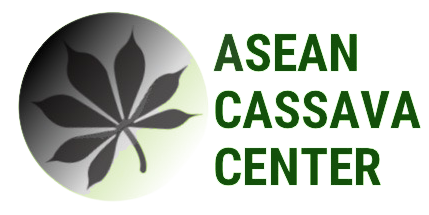Cassava Cultivation
Introduction
Cassava, Manihot esculenta, also known as yucca, mandioca, manioca, tapioca and cassava is a shrubby perennial crop of the Euphorbiaceae (spurge) family. It is extensively cultivated as an annual crop for its edible roots in tropical and subtropical regions, mainly in Latin America, Africa and Asia. Edible roots derived from this crop have a very high starch content, consequently it is employed as a major staple food crop for billions of people, in particular for those who live in developing countries. That is why cassava is recognized as the “food of the poor”. Nevertheless, due to improved world average root yields and multipurpose-use crops, cassava has been proclaimed to be “the crop for the 21st century” by the Food and Agricultural Organization of the United Nations.
Cassava roots are long and tapered, with a firm homogeneous, chalk-white or yellowish flesh covered with a rough, brown peel. The dimensions of the roots vary depending on the variety, growing conditions and age. Typically, the roots are 5 to 10 cm in diameter and 50 to 80 cm long. The roots are very rich in starch and have a low content of protein, lipids and minerals. This composition can vary, depending on genetics and growing conditions.

Cassava roots with conical, conical-cylindrical, cylindrical and fusiform shapes.
Source: Breuninger, W. F., Piyachomkwan, K. and Sriroth, K. (2009)

Cross section of cassava roots with various diameters
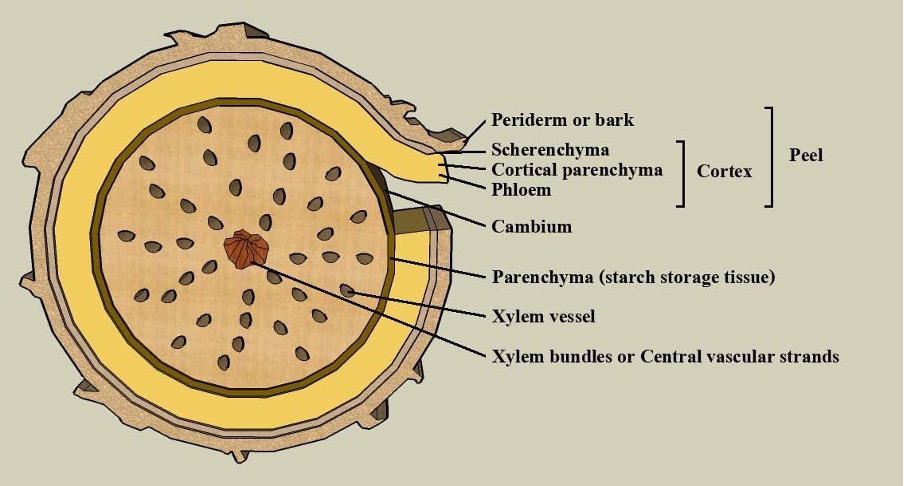
Drawing of cassava root cross section
In contrast to starch from grain, fresh cassava roots consist mainly of water, which causes root spoilage easily due to microbial attack. Considering only the dry matter, starch is the major component found in cassava roots. Only small quantities of protein and lipid are present in cassava roots. Still, the root components are genetic and planting condition dependent. Some minerals such as potassium, iron and phosphorus have been reported in roots of some varieties.
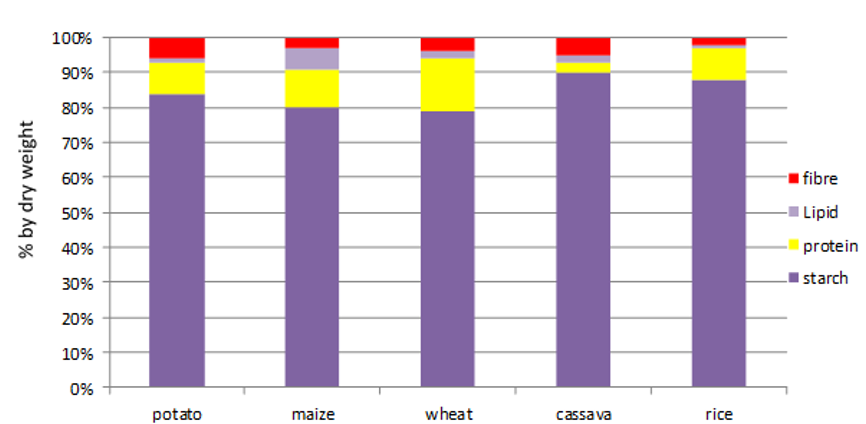
Chemical composition (% by dry weight) of cassava roots as compared to
other major starch materials including potato tubers, grains of maize, wheat and rice.
Root variety
There are different varieties of cassava grown worldwide. Typically, cassava is classified into two types, i.e. sweet and bitter, according to the content of cyanogenic compounds, a toxin found in fresh roots. The sweet variety, such as Hanatee, generally has very low cyanide content, making them suitable for direct consumption. In contrast, the bitter varieties have high cyanide content and are generally used for production of industrial products. In Thailand, most of the cassava varieties grown by farmers are the bitter type. These varieties have been developed since 1975 in order to improve their good agronomic traits and plant phenotype such as high yield, high root dry matter, good adaptability and high tolerance to poor growth conditions.
Thai cassava varieties developed for industrial use
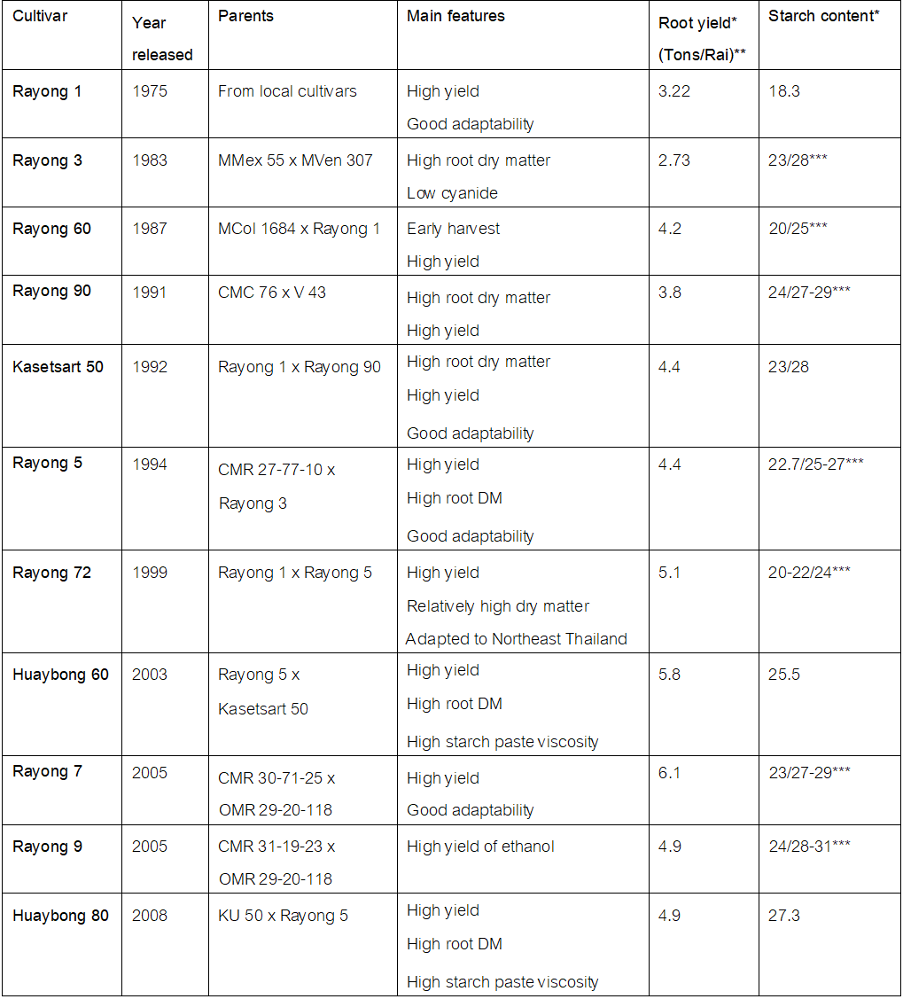
*** The numbers are reported as the starch contents of roots from the rainy season/dry season.
Kasetsart 50 (KU 50)
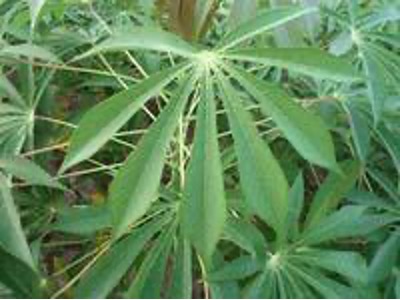
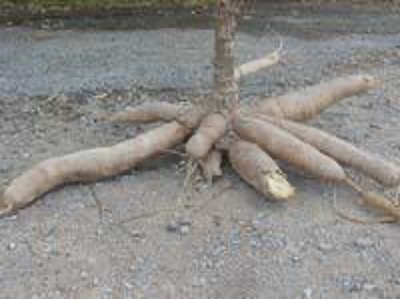
Rayong 5
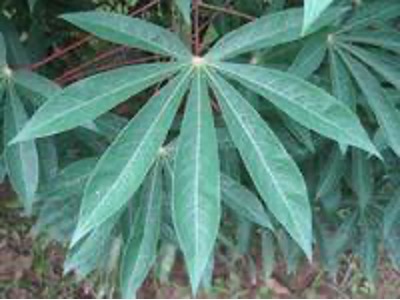
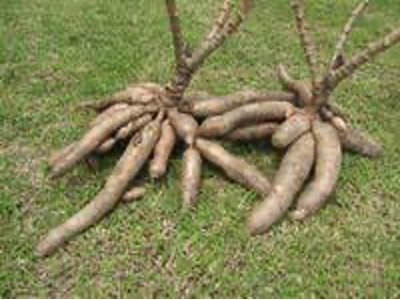
Huaybong 60
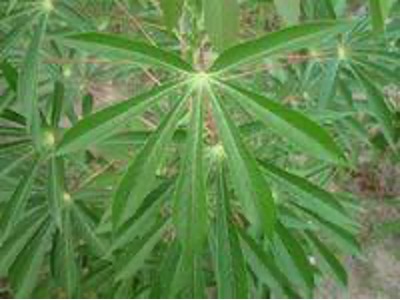
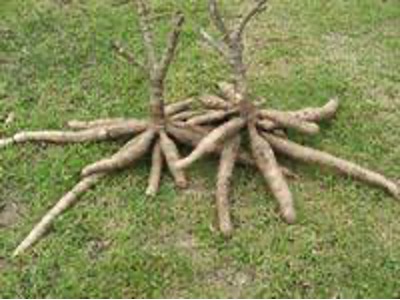
Plant, leaf and root phenotypes of some Thai cassava varieties, officially released by
Department of Agriculture, Ministry of Agriculture and Cooperatives (MOAC), Thailand and mostly grown by Thai farmers.
Cassava cultivation
Cassava is well recognized for its ease of cultivation and low input requirement. The plant can grow in all soil types however, it prefers loose-structure soil such as light sandy loams and loamy sands for its root formation. It can grow even in infertile soil or acid soil (pH 4.2-4.5), but not in alkaline soil (pH > 8). Cassava has excellent drought tolerance so that it can be planted in areas having annual rainfall of less than 1,000 mm.
Planting usually starts at the beginning of the rainy season. The plants are propagated by purging a piece of stem cutting or stakes, being 20 cm in length and having at least 5 nodules, horizontally, vertically or inclined into the soil. For effective propagation, good-quality stakes are obtained from mature plants with 9-12 months growth and are planted vertically, approximately 10 cm in depth below the soil surface and 100 x 100 cm for plant spacing. Less spacing (80 x 100 cm or 80 x 80 cm) is recommended for infertile sandy soil whereas larger spacing (100 x 120 cm or 120 x 120 cm) is applied in fertile soil. By vertical planting (or “standing”), the mature plants hold at least two big branches (i.e. dichotomous branching) or three branches (i.e. trichotomous branching). At maturity, which is reached in 8 - 12 months, plant tops may be 1 - 5 m high, with roots extending 1 m into the soil.
The roots are typically harvested on average at 8-12 months after planting. Early or delayed harvest may result in lower root yields and root starch content. Root harvesting can be accomplished manually by cutting the stem at a height of 30 cm above the ground. Roots are then pulled out from the ground by using an iron or wood stake with a fulcrum point in between the branches of the plant. Leaves are left in the field as soil improvers and fertilizers while plant tops are cut into pieces for replanting and roots are delivered to the processing factory.
Regular check for insects and diseases
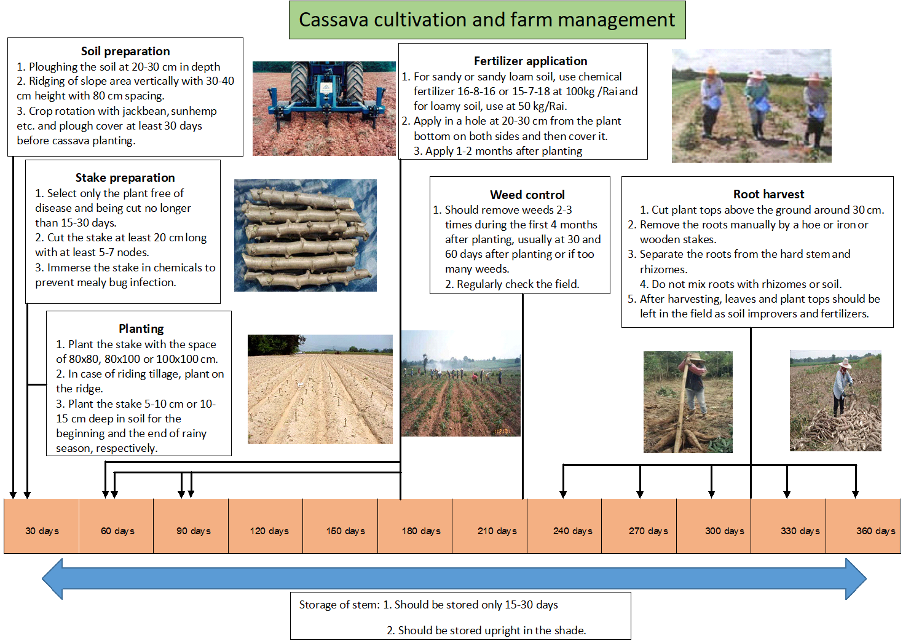
References
Breuninger, W. F., Piyachomkwan, K. and Sriroth, K. (2009). Tapioca/cassava Starch: Production and use. In: Starch Chemistry and Technology, BeMiller, J. and Whistler, R. 3rd ed. Academic Press, New York. pp. 541-568.
